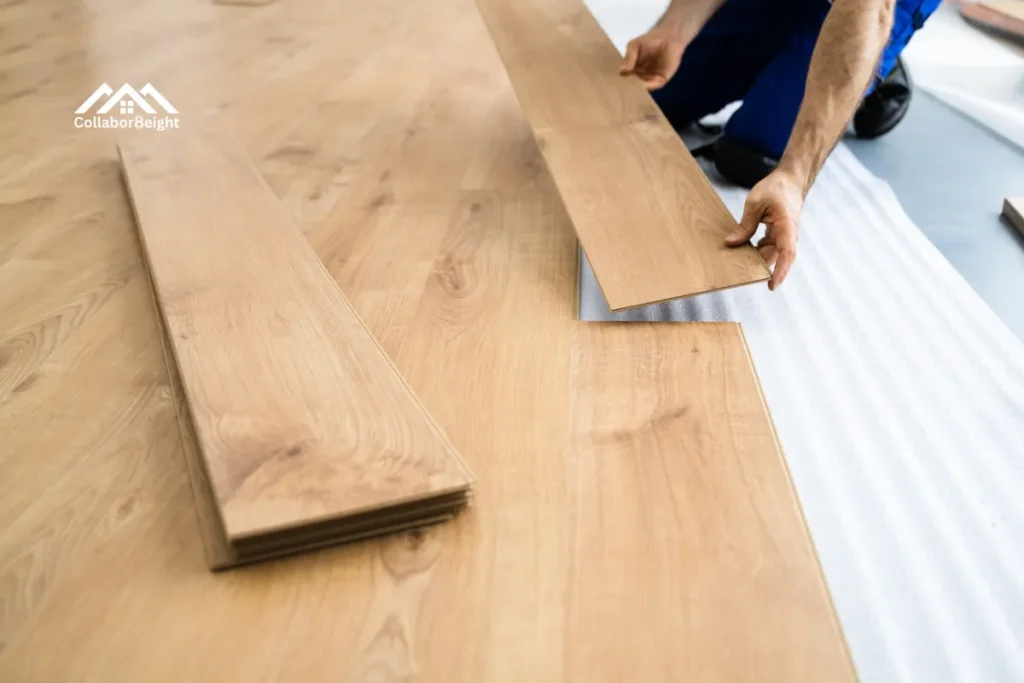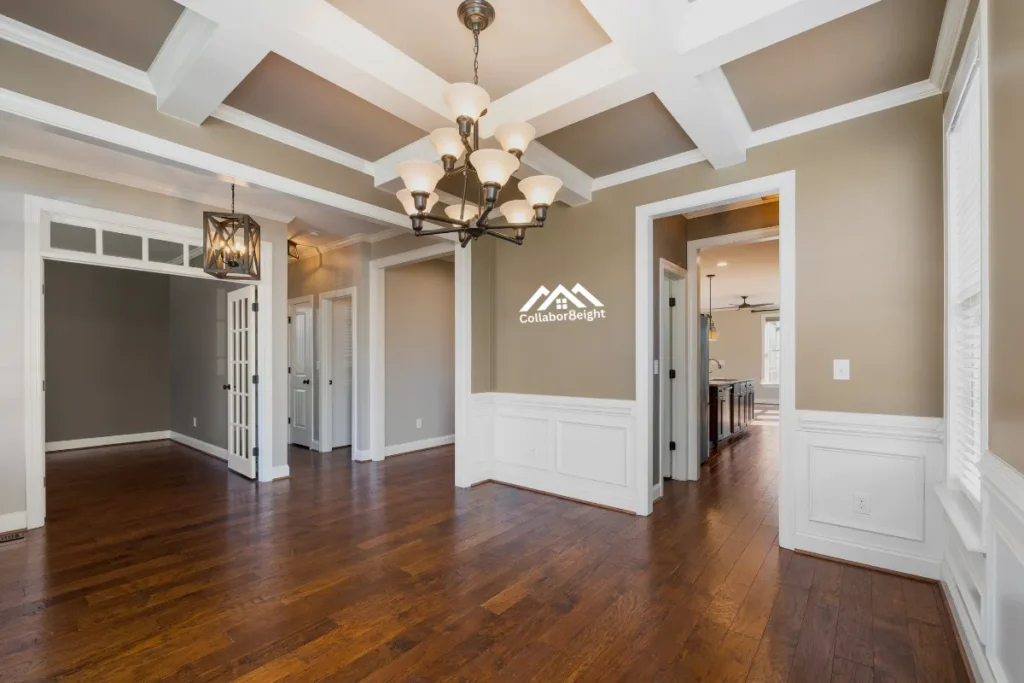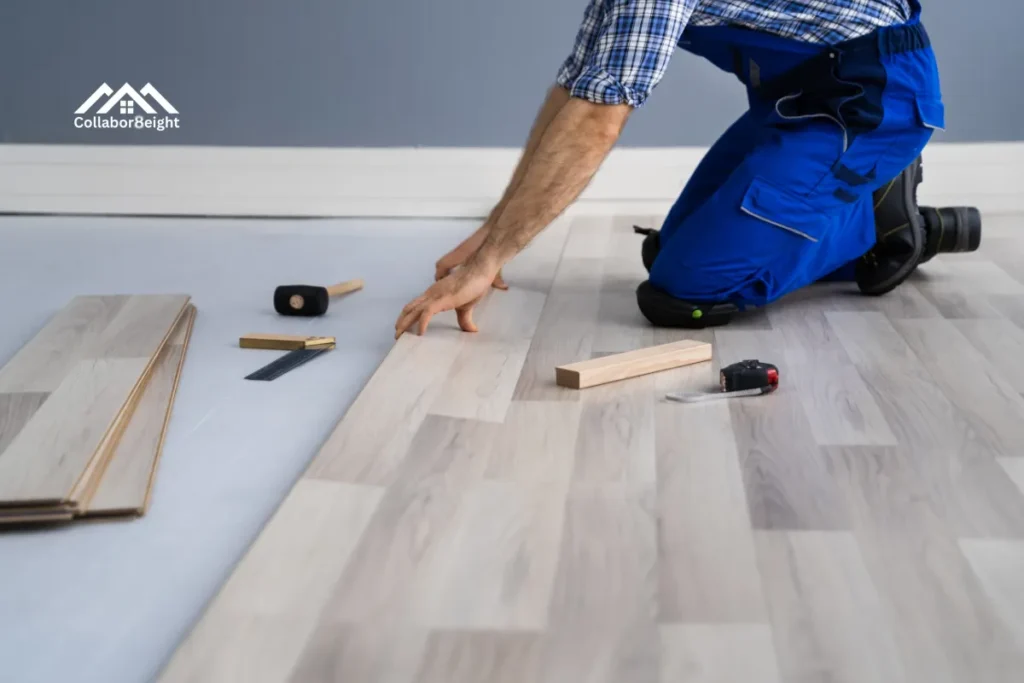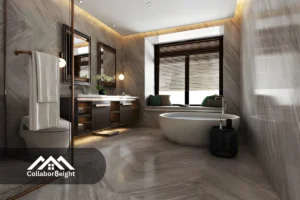Introduction to Engineered Hardwood Flooring
Why Choose Engineered Hardwood Flooring?
When it comes to upgrading your home, few things make a bigger impact than your floors. Engineered hardwood flooring has become one of the top choices for homeowners across the U.S., & it’s easy to see why. But what exactly is engineered hardwood flooring, & how is it different from traditional hardwood?
What Makes Engineered Hardwood Floors Unique?
Let’s start simple. Imagine a sandwich. On the top, you have a thin, beautiful layer of real hardwood, the part you actually see & walk on. Below that are multiple layers of wood pressed together in different directions, giving it strength & stability. That’s engineered hardwood floors in a nutshell. Unlike solid hardwood, which can expand, contract, or even warp with changes in humidity, engineered hardwood flooring is designed to handle life’s ups & downs with grace. It’s perfect for kitchens, basements, or rooms where solid wood might struggle.
Engineered Wood Flooring vs Hardwood
Now, you might be wondering, “How does engineered wood flooring vs hardwood really compare?” Here’s the scoop: while solid hardwood is thicker & can be sanded & refinished more times, engineered hardwood floors are much more resistant to moisture, temperature changes, & everyday wear. That means fewer worries about cracks, gaps, or dents. Plus, it’s usually quicker to install, which is a huge win if you don’t want your home to turn into a construction zone for weeks.
Finding the Best Engineered Hardwood Flooring
If you’re shopping for the best engineered hardwood flooring, you’ll find plenty of options with different wood species, finishes, & plank sizes. From classic oak to rich walnut, there’s a look for every taste. And the beauty isn’t just skin deep, these floors combine style with strength, giving you a surface that’s not only gorgeous but built to last.
Why Homeowners Love Engineered Hardwood Flooring
Whether you’re upgrading one room or renovating an entire house, engineered hardwood flooring offers a smart balance of elegance, practicality & durability. It’s no wonder more homeowners are choosing engineered hardwood floors over traditional hardwood every day. And if you’ve been hesitant about committing, don’t worry, we’ll walk you through everything you need to know, including costs, maintenance tips, & installation secrets, so you can confidently choose the perfect engineered hardwood floor for your home.
Benefits of Engineered Hardwood Flooring
1. Durability & Long-Lasting Beauty
One of the biggest reasons homeowners choose engineered hardwood flooring is its durability. Unlike solid wood, engineered hardwood floors are built to withstand changes in temperature & humidity without warping or cracking. That means your floors can stay beautiful for years, even in areas like kitchens or basements where traditional hardwood might struggle. Plus, the top hardwood layer gives you the authentic look & feel of real wood, so your home still looks elegant & cozy.
2. Easy Installation & Flexibility
Installing engineered hardwood flooring is easier than you might think. Whether you choose a floating, glue-down, or nail-down method, these floors are designed to fit a variety of spaces. Many homeowners even take the DIY route, thanks to the flexibility of engineered hardwood floors. If you’re comparing engineered wood flooring vs hardwood, you’ll notice that engineered options often save time & effort without sacrificing quality.
3. Moisture & Temperature Resistance
Unlike traditional hardwood, which can swell or shrink when exposed to moisture, engineered hardwood flooring has multiple layers pressed together for stability. This makes it more resistant to water spills, humidity, & seasonal changes. So, if you live in a humid area or have a basement room, engineered hardwood floors are a smart choice that keeps your home looking polished & worry-free.
4. Stylish Options for Every Home
When it comes to finding the best engineered hardwood flooring, the choices are endless. From white oak to walnut, wide planks to narrow planks, you can create a look that matches your personal style. Engineered hardwood floor finishes come in matte, semi-gloss, & high-gloss, giving you the power to customize your space with elegance & charm.
5. Cost-Effective & Smart Investment
While traditional hardwood can be pricey, engineered hardwood flooring offers a more budget-friendly option without sacrificing quality. It’s durable, long-lasting, & adds value to your home. When you invest in engineered hardwood floors, you get the beauty of real wood with less worry about repairs, replacements, or damage, making it one of the smartest home investments you can make.
6. Eco-Friendly & Sustainable
Many engineered hardwood flooring options are sourced from sustainable forests & use less wood than solid hardwood. This means you get a gorgeous floor that’s also better for the environment. Choosing engineered hardwood floors lets you enjoy a stylish, durable home while supporting eco-friendly practices.
Potential Drawbacks of Engineered Hardwood Flooring
1. Limited Refinishing Options
While engineered hardwood floors are durable, they have a thinner top hardwood layer compared to solid wood. This means you can’t sand & refinish them as many times. If your floor gets deep scratches or heavy wear over the years, the engineered hardwood floor might only allow 1–2 refinishes before it’s no longer safe to sand. So, if you love the idea of refinishing your floors multiple times, keep this in mind.
2. Can Be Sensitive to Excessive Moisture
Even though engineered hardwood flooring handles moisture better than solid wood, it’s not completely waterproof. Standing water, leaks, or high humidity over long periods can damage engineered hardwood floors. You’ll need to wipe spills quickly & maintain proper humidity levels in your home to keep your floors looking perfect.
3. Potential Price Variation
Depending on the wood species, plank width, & brand, engineered hardwood flooring can range from affordable to quite expensive. Some premium engineered hardwood floors offer thicker wear layers & exotic wood finishes, which can increase the price. It’s important to find a balance between quality & budget to get the best engineered hardwood flooring for your home.
4. Installation Mistakes Can Be Costly
While many engineered hardwood floors are easier to install than traditional hardwood, improper installation can lead to gaps, squeaks, or uneven surfaces. If you’re attempting DIY installation, make sure to follow instructions carefully. Otherwise, hiring a professional ensures your engineered hardwood floor lasts for years without issues.
5. Color Fading Over Time
Direct sunlight can affect some engineered hardwood flooring finishes. Over time, floors may fade or change color slightly. Using area rugs, window treatments, & rotating furniture can help minimize this, keeping your engineered hardwood floors looking vibrant & fresh.
Popular Wood Species & Styles
1. White Oak: Classic & Versatile
White oak is one of the most popular choices for engineered hardwood flooring. Its light, natural color works well in any room, from bright kitchens to cozy living rooms. Engineered hardwood floors in white oak give your space a timeless look that blends with both modern & traditional interiors. Plus, it’s durable, so it handles high-traffic areas like hallways or family rooms without losing its charm.
2. Maple: Smooth & Elegant
If you’re looking for a sleek, contemporary style, maple is a great option. Engineered hardwood floor made from maple has a smooth grain that creates a clean, polished appearance. Maple floors are slightly harder than oak, making them perfect for homes with kids & pets who can be tough on flooring.
3. Hickory: Bold & Eye-Catching
Hickory offers strong character & unique color variations, from pale cream to rich brown. Choosing engineered hardwood flooring in hickory adds warmth & personality to your home. Its natural patterns make each plank feel one-of-a-kind, giving your engineered hardwood floors a distinctive look you won’t see anywhere else.
4. Walnut: Rich & Luxurious
For a deep, luxurious feel, walnut is the go-to. Engineered hardwood floor in walnut brings a sense of elegance & sophistication to any room. Its dark tones pair beautifully with light walls, creating a stunning contrast that enhances the overall design. Walnut floors are ideal for dining rooms, offices, or master bedrooms where you want a refined, stylish appearance.
5. Wide Planks vs Narrow Planks
The width of your engineered hardwood flooring planks can dramatically change the feel of a room. Wide planks make spaces feel larger & more open, while narrow planks add texture & a traditional vibe. Both styles work beautifully with various wood species, allowing you to customize your engineered hardwood floors to fit your style & space.
6. Prefinished vs Unfinished
Engineered hardwood flooring comes in prefinished or unfinished options. Prefinished floors are ready to walk on right after installation, saving you time & effort. Unfinished floors give you the freedom to choose your own stain & finish, letting you create a truly personalized look. Both options ensure your engineered hardwood floor looks stunning for years.
Installation Methods for Engineered Hardwood Flooring

1. Floating Installation
One of the easiest ways to install engineered hardwood floors is using the floating method. Here, the planks are not glued or nailed down, they “float” above the subfloor. This method is great for DIYers, saves time, & allows the floor to expand & contract naturally. Floating engineered hardwood flooring works well over concrete, plywood, or even existing floors, giving you flexibility & convenience.
2. Glue-Down Installation
With the glue-down method, the engineered hardwood floor is adhered directly to the subfloor using special flooring glue. This creates a very stable & solid surface. Glue-down engineered hardwood flooring is ideal for basements or rooms where you want extra moisture resistance & minimal movement. It’s slightly more work than floating floors, but the result is a smooth, durable surface.
3. Nail-Down Installation
Nail-down installation is a traditional method, often used with plywood subfloors. Nails or staples secure each plank in place, creating a firm & long-lasting engineered hardwood floor. While this method is more labor-intensive, it gives your floors a classic feel & is perfect for solid subfloors in living rooms or bedrooms.
4. DIY vs Professional Installation
Installing engineered hardwood flooring yourself can be rewarding, especially if you’re handy & enjoy projects. Floating floors are the easiest DIY option, while glue-down & nail-down methods might need professional expertise. Hiring a professional ensures your engineered hardwood floors are installed perfectly, with no gaps, squeaks, or uneven planks.
5. Tips for a Smooth Installation
- Acclimate your engineered hardwood flooring by letting the planks sit in the room for a few days before installation.
- Prepare the subfloor by cleaning & leveling it properly.
- Use spacers along walls to allow room for expansion & contraction.
- Follow the manufacturer’s guidelines for your specific engineered hardwood floor.
Maintenance & Care for Engineered Hardwood Flooring
1. Daily Cleaning Made Easy
Keeping your engineered hardwood floors looking gorgeous doesn’t have to be hard. Sweep or vacuum regularly to remove dust & dirt that can scratch the surface. For deeper cleaning, use a damp (not wet) mop with a cleaner made for engineered hardwood flooring. Avoid harsh chemicals or soaking the wood, as moisture can damage your engineered hardwood floor over time.
2. Preventative Measures
A few simple steps can protect your engineered hardwood flooring for years:
- Use rugs in high-traffic areas & entryways to trap dirt.
- Place furniture pads under chairs & tables to prevent scratches.
- Maintain indoor humidity between 35–55% to prevent gaps or warping.
3. Handling Spills & Stains
Accidents happen! Wipe up spills immediately to prevent moisture from seeping into your engineered hardwood floors. For tougher stains, use a cleaner recommended by the manufacturer to keep your engineered hardwood floor looking like new. Quick action keeps the wood beautiful & prevents long-term damage.
4. Refinishing & Repairs
While engineered hardwood flooring can’t be refinished as many times as solid hardwood, it’s still possible to refresh your floors depending on the thickness of the top layer. Small scratches or dents can often be repaired with wood fillers or touch-up kits, helping your engineered hardwood floors stay flawless without a full replacement.
5. Long-Term Care Tips
- Rotate furniture occasionally to prevent uneven wear.
- Keep pets’ nails trimmed to reduce scratches.
- Avoid walking on your engineered hardwood flooring with high heels or cleats.
By following these simple steps, your engineered hardwood floors will remain stunning, durable, & enjoyable for many years.
Cost & Value Analysis of Engineered Hardwood Flooring
1. Understanding the Price Range
When shopping for engineered hardwood flooring, prices can vary widely depending on the wood species, plank width, wear layer thickness, & brand. On average, you can expect to pay between $4 & $10 per square foot for most U.S. homes. Premium options, like exotic woods or wider planks, can cost even more. While it may seem pricey upfront, investing in engineered hardwood floors is often cheaper than solid hardwood without compromising on beauty & durability.
2. Factors That Affect Cost
Here are the main factors that influence the price of your engineered hardwood floor:
- Wood species: Oak, maple, hickory, & walnut all vary in price.
- Plank size & thickness: Wider or thicker planks are more expensive.
- Finish type: Prefinished floors may cost more but save time & installation hassle.
- Brand reputation: Top-rated brands often provide better quality & warranties.
3. Comparing Engineered Wood Flooring vs Hardwood
If you’re torn between engineered wood flooring vs hardwood, consider long-term value. Engineered hardwood flooring can handle moisture & temperature changes better, which reduces maintenance & replacement costs. While solid hardwood may last longer with multiple refinishes, engineered hardwood floors provide a practical, cost-effective solution for most homeowners.
4. Long-Term Investment & ROI
Investing in the best engineered hardwood flooring adds value to your home. It’s not just a surface, it’s a statement. Beautiful, durable floors can make your property more attractive to buyers, increase resale value, & enhance your everyday living experience. When done right, your engineered hardwood floor pays for itself over time through longevity, low maintenance, & aesthetic appeal.
5. Cost-Saving Tips
- Shop for sales & promotions from reputable U.S. flooring retailers.
- Consider slightly thinner wear layers for areas with less traffic.
- Combine DIY installation with professional guidance for hybrid savings.
By understanding costs & factors that affect them, you can choose the best engineered hardwood flooring that fits your budget while giving you long-lasting style & value.
Brand Comparisons & Reviews for Engineered Hardwood Flooring
1. Why Brand Matters
When choosing engineered hardwood flooring, the brand can make a big difference in quality, durability, & style. Different manufacturers offer varying wear layer thicknesses, wood species, finishes, & warranties. Picking the right engineered hardwood floor ensures you get a product that lasts, looks amazing, & performs well in your home.
2. Top U.S. Brands
Here are some of the most trusted brands for engineered hardwood floors:
- Bruce Hardwood: Known for durable finishes & wide plank options.
- Mohawk: Offers affordable engineered hardwood flooring with eco-friendly options.
- Shaw Floors: High-quality engineered hardwood floors with excellent warranty coverage.
- Kährs: Premium European brand offering top-tier engineered hardwood flooring with unique styles.
3. Comparing Features
When reviewing brands, consider these key features:
- Wear Layer Thickness: Thicker layers allow more refinishing & longer lifespan.
- Plank Width & Style: Wide planks create a spacious look, while narrow planks offer a traditional vibe.
- Finish & Texture: Matte, semi-gloss, or hand-scraped options impact style & maintenance.
- Warranty: Good brands back their engineered hardwood floors with solid warranties to protect your investment.
4. Customer Feedback
Most homeowners love the convenience & beauty of engineered hardwood flooring. They praise its stability in kitchens, basements, & other high-traffic areas. Some note minor scratches over time, but proper maintenance keeps engineered hardwood floors looking pristine. Checking reviews helps you select the best engineered hardwood flooring for your specific needs.
5. Finding the Best Option
When choosing a brand, think about your lifestyle, budget, & design preferences. Look for trusted reviews, warranty details, & long-term performance. The right engineered hardwood floor combines style, durability, & value, ensuring your home looks beautiful for years.
Hidden Insights & Common Myths About Engineered Hardwood Flooring
1. Myth: Engineered Hardwood Floors Are Not Real Wood
Some people think engineered hardwood flooring isn’t “real” because it has layers. The truth is, the top layer is 100% real hardwood. You get all the natural beauty & texture of wood, with the added strength & stability from the underlying layers. So, when comparing engineered wood flooring vs hardwood, you’re still getting genuine wood that looks & feels authentic.
2. Myth: Engineered Hardwood Can’t Be Installed Everywhere
A common misconception is that engineered hardwood flooring can’t be used in basements or kitchens. Actually, its layered construction makes it more resistant to moisture & temperature changes than solid hardwood. That means you can enjoy engineered hardwood floors in almost any room, even areas where traditional hardwood might struggle.
3. Hidden Insight: It’s Eco-Friendly
Many homeowners don’t realize that engineered hardwood flooring can be more sustainable than solid wood. Because it uses less top-layer wood & incorporates plywood or fiberboard layers, it saves resources while still providing the beauty of real wood. Choosing engineered hardwood floors lets you make a stylish, environmentally friendly choice for your home.
4. Hidden Insight: Longevity Depends on Maintenance
While engineered hardwood flooring is durable, how long it lasts depends largely on how you care for it. Regular cleaning, preventing scratches, & controlling indoor humidity can dramatically extend the life of your engineered hardwood floor. Many people underestimate the importance of maintenance, but it’s key to keeping your floors gorgeous for decades.
5. Myth: All Engineered Hardwood Floors Are the Same
Not all engineered hardwood flooring is created equal. Differences in wear layer thickness, wood species, finish, & manufacturing process affect durability, appearance, & cost. That’s why choosing the best engineered hardwood flooring requires careful research & comparison to ensure you get high quality without overspending.
Buying Tips & Recommendations for Engineered Hardwood Flooring

1. Set Your Budget First
Before shopping, decide how much you’re willing to spend on engineered hardwood flooring. Remember, prices vary based on wood species, plank width, finish, & brand. Setting a budget helps narrow down your options & ensures you find the best engineered hardwood flooring for your home without overspending.
2. Consider Your Lifestyle
Think about how much traffic your floors will see. If you have kids, pets, or a busy household, you’ll want engineered hardwood floors with thicker wear layers & durable finishes. High-traffic areas benefit from more resilient options, while bedrooms or less-used spaces can handle softer species.
3. Compare Engineered Wood Flooring vs Hardwood
If you’re debating between engineered wood flooring vs hardwood, consider factors like moisture resistance, installation ease, & maintenance. Engineered hardwood flooring is often more practical for basements, kitchens, & areas prone to humidity, while solid hardwood may be better for rooms where longevity & multiple refinishes matter.
4. Check Reviews & Warranties
Look for customer reviews to understand real-world performance of different engineered hardwood floors. Also, check warranties, brands offering solid coverage usually indicate confidence in their product. A good warranty can give you peace of mind & protect your engineered hardwood floor investment.
5. Choose the Right Wood Species & Style
Pick a wood species & finish that complements your home’s décor. From oak & maple to hickory & walnut, there’s a style for every taste. Don’t forget to consider plank width & prefinished vs unfinished options to achieve your desired look with engineered hardwood flooring.
6. Decide Between DIY & Professional Installation
Some engineered hardwood floors are perfect for DIY installation, especially floating floors. Others, like glue-down or nail-down, may require a professional. Think about your skill level, tools, & the room size to ensure a smooth, long-lasting installation.
7. Inspect Before You Buy
Finally, inspect the planks for consistency in color, finish, & thickness. This ensures your engineered hardwood flooring looks uniform & high-quality once installed. Small differences can affect the final appearance & satisfaction with your floor.
Final Thought
Engineered hardwood flooring combines beauty, durability & style, making it a smart choice for any home. With the right care & installation, your engineered hardwood floors will last for years, adding value & charm. Whether you’re choosing the best engineered hardwood flooring or comparing engineered wood flooring vs hardwood, these floors are a practical & elegant investment.
FAQs
1. What is engineered hardwood flooring?
Engineered hardwood flooring is made of a top layer of real hardwood over multiple layers of wood, offering durability, stability, & the authentic look of wood.
2. How does engineered wood flooring vs hardwood compare?
Engineered hardwood floors handle moisture & temperature changes better than solid hardwood, while still providing the beauty & feel of real wood.
3. What is the best engineered hardwood flooring?
The best engineered hardwood flooring depends on your needs, budget, & style. Popular U.S. options include oak, maple, hickory, & walnut in prefinished or unfinished planks.
4. Can engineered hardwood flooring be installed in basements or kitchens?
Yes! Engineered hardwood flooring is more resistant to moisture than solid wood, making it suitable for kitchens, basements, & most other rooms.
5. How do I maintain engineered hardwood floors?
Sweep or vacuum regularly, use a damp mop with a hardwood-safe cleaner, wipe up spills immediately, & protect floors with furniture pads & rugs. Proper care keeps engineered hardwood floors looking great for years.





